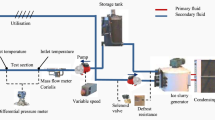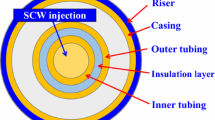Abstract
The ice crystal particles are easy to enter into the seawater cooling system of polar ship together with seawater when it sails in the Arctic. They are easy to accumulate in the pipeline, causing serious blockage of the cooling pipe. In this study, the flow and melting characteristics of ice particles-seawater two-phase flow in inlet straight pipe of shell-and-tube heat exchanger were numerically simulated by using Eulerian-Eulerian two-fluid model coupled with the interphase heat and mass transfer model. The influences of inlet ice packing factor, ice crystal particle diameter, and inlet velocity on the distribution and melting characteristics of ice crystals were investigated. The degree of asymmetry of the distribution of ice crystals in the cross section decreases gradually when the IPF changes from 5 to 15%. The volume fractions of ice crystals near the top of the outlet cross section are 19.59, 19.51, and 22.24% respectively for ice packing factor of 5, 10 and 15%. When the particle diameter is 0.5 mm, the ice crystals are gradually stratified during the flow process. With particle diameters of 1.0 and 2.0 mm, the region with the highest volume fraction of ice crystals is a small circle and the contours in the cloud map are compact. The greater the inlet flow velocity, the less stratified the ice crystals and the more obvious the turbulence on the outlet cross section. The average volume fraction of ice crystals along the flow direction is firstly rapidly reduced and then stabilized after 300 mm.













Similar content being viewed by others
Abbreviations
- C D :
-
Drag force coefficient
- d s :
-
Solid particle diameter, mm
- e ss :
-
Particles-particles restitution coefficient
- F :
-
Force, N
- go :
-
Particle radial distribution function
- h :
-
Enthalpy, J·kg−1
- hv :
-
Interphase heat transfer coefficient
- ΔH :
-
Latent heat, kJ·kg−1
- I :
-
Unit vector
- \( {k}_{\theta_s} \) :
-
Diffusion coefficient
- k sl :
-
Momentum exchange coefficient
- k :
-
Auxiliary parameter
- \( \dot{m} \) :
-
Mass transfer rate, kg·m·s−1
- P r :
-
Prandtl number
- P :
-
Pressure, pa
- Res :
-
Reynolds number
- T :
-
Temperature, k
- U :
-
Mean velocity, m·s−1
- v :
-
Velocity, m·s−1
- ρ :
-
Density, kg·m−3
- α :
-
Volume fraction, vol%
- λ :
-
Thermal conductivity, W·m−1·K−1
- μ :
-
Viscosity, Pa·s
- ξ:
-
Bulk viscosity, Pa·s
- τ :
-
Stress tensor, pa
- θ s :
-
Particle temperature, k
- \( {\gamma}_{\theta_s} \) :
-
Collisional dissipation of energy, kg·m−1·s−3
- δ ls :
-
Energy of the interphase conversion, kg·m−1·s−3
- D :
-
Diameter
- l :
-
Liquid
- s :
-
Solid
References
Sidortsov R (2016) A perfect moment during imperfect times: Arctic energy research in a low-carbon era. J Energy Res Soc Sci 16:1–7
Andreassen N (2016) Arctic energy development in Russia-How “sustainability” can fit? J Energy Res Soc Sci 16:78–88
Nong H (2012) The melting Arctic and its impact on China’s maritime transport. J Res Transp Econ 35:50–57
Gulas S, Downton M (2017) Declining Arctic ocean oil and gas developments: opportunities to improve governance and environmental pollution control. J Marine Policy 75:54–61
Aksenov Y, Popova EE, Yool A (2017) On the future navigability of Arctic sea routes: high-resolution projections of the Arctic Ocean and sea ice. J Marine Policy 75:300–317
Shi XJ, Zhang P (2016) Conjugated heat and mass transfer during flow melting of a phase change material slurry in pipes. J Energy 99:58–68
Kumano H, Hirata T (2011) Experimental study on the flow and heat transfer characteristics of a tetra-n-butyl ammonium bromide hydrate slurry (second report: heat transfer characteristics). Int J Refrig 34:1963–1971
Ma F, Zhang P, Shi XJ (2017) Flow and heat transfer characteristics of micro-encapsulated phase change material slurry and energy transport evaluation. J Energy Procedia 105:4607–4614
Asaoka T, Tajima A, Kumano H (2016) Experimental investigation on inhomogeneity of ice packing factor in ice slurry flow. Int J Refrig 70:33–41
Kumano H, Asaoka T, Sawada S (2014) Effect of initial aqueous solution concentration and heating conditions on heat transfer characteristics of ice slurry. Int J Refrig 41:72–81
Knodel BD, France DM (2000) Heat transfer and pressure drop in ice-water slurries. J Appl Therm Eng 20:671–685
Shi XJ, Zhang P (2016) Two-phase flow and heat transfer characteristics of tetra-n-butyl ammonium bromide clathrate hydrate slurry in horizontal 90° elbow pipe and U-pipe. Int J Heat Mass Tran 97:364–378
Zhu JY, Tang SY, Yi P (2017) Enhancement of laminar convective heat transfer using microparticle suspensions. Heat Mass Transf 53(1):169–176
Raman S, Jan M, Falah A (2017) Euler-Euler CFD simulation of the fuel reactor of a 1 MWth chemical-looping pilot plant: Influence of the drag models and specularity coefficient. J Fuel 200:435–446
Niezgoda-Zelasko B, Zalewski W (2006) Momentum transfer of ice slurry flows in tubes, modeling. J Int J Refrig 29:429–436
Zhang P, Jiang YY (2014) Forced convective heat transfer of slush nitrogen in a horizontal pipe. Int J Heat Mass Tran 71:158–171
Gunn DJ (1978) Transfer of heat or mass to particles in fixed and fluidized beds. J Heat Mass Transfer 21:467–476
Burns ADB, Frank Th et al (2004) The favre averaged drag model for turbulent dispersion in eulerian multi-phase flows. Fifth international conference on multiphase flow, ICMF-2004, Yokohama, Japan
Gidaspow D (1994) Multiphase flow and fluidization: continuum and kinetic theory descriptions. Academic Press, New York, pp 314–315
Gidaspow D, Bezburuah R, Ding J (1992) Hydrodynamics of circulating fluidized beds, kinetic theory approach. In: Fluidization VII, proceedings of the 7th engineering foundation conference on fluidization. Australia, Brisbane 75–82
Ekambara K, Sanders RS, Nandakumar K (2009) Hydrodynamic simulation of horizontal slurry pipeline flow using ANSYS-CFX. J Ind Eng Chem Res 48:8159–8171
Lun CKK, Savage SB et al (1984) Kinetic theories for granular flow: inelastic particles in Couette flow and slightly inelastic particles in a general flow field. J Fluid Mech 140:223–256
Cavalieri DJ, Parkinson CL (2012) Arctic sea ice variability and trends, 1979-2010. J Cryosphere 6:881–889
Laxon SW, Giles KA (2013) CryoSat-2 estimates of Arctic sea ice thickness and volume. J Geophys Res Lett 40:732–737
Wang Q, Ilicak M et al (2016) An assessment of the Arctic Ocean in a suite of interannual CORE-II simulations. Part I: sea ice and solid freshwater. J Ocean Model 99:110–132
Zhu CF (2010) The study of heat-transferring characteristics for ice-making process of seawater ice-made machine. Master Thesis, South China University of Technology, China. In Chinese
Sharqawy MH, Lienhard JH, Zubair SM (2011) On thermal performance of seawater cooling towers. J Eng Gas Turb Power 4:1–7
Karwa R (2017) Heat and Mass Transfer. Springer, Singapore, pp 865–928
Ayel V, Lottin O, Peerhossaini H (2003) Rheology flow behavior and heat transfer of ice slurries: a view of the state of the art. Int J of Refri 26:95–107
Gao HP, Ye XS (2014) Design and analysis of shell and tube heat exchangers. J Chem Eng and Equip 5:122–123 In Chinese
Qian SW (2002) Heat exchanger design manual. Chemical Industry Press, Beijing, pp 32–34 In Chinese
Wang JH, Wang SG et al (2013) Numerical investigation of ice slurry isothermal flow in various pipes. J Refrig 36:70–80
Gillies RG, Shook CA (1994) Concentration distributions of sand slurries in horizontal pipe flow. J Part Sci Technol 12:45–69
Matousek V (2002) Pressure drops and flow patterns in sand-mixture pipes. J Exp Therm Fluid Sci 26:693–702
Ma ZW, Zhang P (2013) Modeling the heat transfer characteristics of flow melting of phase change material slurries in the circular tubes. Int J Heat Mass Tran 64:874–881
Acknowledgements
This work is financially supported by the National Natural Science Foundation of China (Grant no. 51479152).
Author information
Authors and Affiliations
Corresponding author
Additional information
Publisher’s Note
Springer Nature remains neutral with regard to jurisdictional claims in published maps and institutional affiliations.
Rights and permissions
About this article
Cite this article
Xu, L., Huang, CX., Huang, ZF. et al. Numerical simulation of flow and melting characteristics of seawater-ice crystals two-phase flow in inlet straight pipe of shell and tube heat exchanger of polar ship. Heat Mass Transfer 54, 3345–3360 (2018). https://doi.org/10.1007/s00231-018-2344-0
Received:
Accepted:
Published:
Issue Date:
DOI: https://doi.org/10.1007/s00231-018-2344-0




